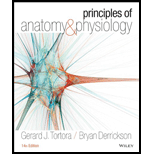
Principles of Anatomy and Physiology
14th Edition
ISBN: 9781118345009
Author: Gerard J. Tortora
Publisher: WILEY
expand_more
expand_more
format_list_bulleted
Question
Chapter 24, Problem 12CP
Summary Introduction
To review:
The regulation of saliva secretion.
Introduction:
Saliva is the secretion that is produced by salivary glands for the breakdown of food particles. The secretion of saliva is called salivation.
Expert Solution & Answer
Want to see the full answer?
Check out a sample textbook solution
Students have asked these similar questions
Not part of a graded assignment, from a past midterm
Not part of a graded assignment, from a past midterm
Please answer question! Not a graded assignment, just a past midterm question
Chapter 24 Solutions
Principles of Anatomy and Physiology
Ch. 24 - Which components of the digestive system are GI...Ch. 24 - 2. Which organs of the digestive system come in...Ch. 24 - Which kinds of food molecules undergo chemical...Ch. 24 - Prob. 4CPCh. 24 - 5. Name the four layers of the gastrointestinal...Ch. 24 - Prob. 6CPCh. 24 - Prob. 7CPCh. 24 - Prob. 8CPCh. 24 - Prob. 9CPCh. 24 - Prob. 10CP
Ch. 24 - How are the major salivary glands distinguished on...Ch. 24 - Prob. 12CPCh. 24 - What functions do incisors, cuspids, premolars,...Ch. 24 - To which two organ systems does the pharynx...Ch. 24 - Prob. 15CPCh. 24 - Prob. 16CPCh. 24 - Prob. 17CPCh. 24 - Prob. 18CPCh. 24 - Prob. 19CPCh. 24 - 20. Compare the epithelium of the esophagus with...Ch. 24 - Prob. 21CPCh. 24 - Prob. 22CPCh. 24 - What are the functions of gastric lipase and...Ch. 24 - Prob. 24CPCh. 24 - Prob. 25CPCh. 24 - Prob. 26CPCh. 24 - Prob. 27CPCh. 24 - Prob. 28CPCh. 24 - Prob. 29CPCh. 24 - Prob. 30CPCh. 24 - Describe the major functions of the liver and...Ch. 24 - 32. List the regions of the small intestine and...Ch. 24 - Prob. 33CPCh. 24 - Describe the types of movement that occur in the...Ch. 24 - Prob. 35CPCh. 24 - What is the difference between digestion and...Ch. 24 - By what routes do absorbed nutrients reach the...Ch. 24 - 38. Describe the absorption of electrolytes,...Ch. 24 - What are the major regions of the large intestine?Ch. 24 - Prob. 40CPCh. 24 - 41. Describe the mechanical movements that occur...Ch. 24 - What is defecation, and how does it occur?Ch. 24 - Prob. 43CPCh. 24 - What is the purpose of the cephalic phase of...Ch. 24 - Prob. 45CPCh. 24 - 46. Outline the steps of the enterogastric...Ch. 24 - Prob. 47CPCh. 24 - Prob. 48CPCh. 24 - 49. What are the general effects of aging on the...
Knowledge Booster
Similar questions
- What does the heavy dark line along collecting duct tell us about water reabsorption in this individual at this time? What does the heavy dark line along collecting duct tell us about ADH secretion in this individual at this time?arrow_forwardBiology grade 10 study guidearrow_forwardI would like to see a professional answer to this so I can compare it with my own and identify any points I may have missedarrow_forward
- what key characteristics would you look for when identifying microbes?arrow_forwardIf you had an unknown microbe, what steps would you take to determine what type of microbe (e.g., fungi, bacteria, virus) it is? Are there particular characteristics you would search for? Explain.arrow_forwardavorite Contact avorite Contact favorite Contact ୫ Recant Contacts Keypad Messages Pairing ง 107.5 NE Controls Media Apps Radio Nav Phone SCREEN OFF Safari File Edit View History Bookmarks Window Help newconnect.mheducation.com M Sign in... S The Im... QFri May 9 9:23 PM w The Im... My first.... Topic: Mi Kimberl M Yeast F Connection lost! You are not connected to internet Sigh in... Sign in... The Im... S Workin... The Im. INTRODUCTION LABORATORY SIMULATION Tube 1 Fructose) esc - X Tube 2 (Glucose) Tube 3 (Sucrose) Tube 4 (Starch) Tube 5 (Water) CO₂ Bubble Height (mm) How to Measure 92 3 5 6 METHODS RESET #3 W E 80 A S D 9 02 1 2 3 5 2 MY NOTES LAB DATA SHOW LABELS % 5 T M dtv 96 J: ப 27 כ 00 alt A DII FB G H J K PHASE 4: Measure gas bubble Complete the following steps: Select ruler and place next to tube 1. Measure starting height of gas bubble in respirometer 1. Record in Lab Data Repeat measurement for tubes 2-5 by selecting ruler and move next to each tube. Record each in Lab Data…arrow_forward
arrow_back_ios
SEE MORE QUESTIONS
arrow_forward_ios
Recommended textbooks for you
 Human Physiology: From Cells to Systems (MindTap ...BiologyISBN:9781285866932Author:Lauralee SherwoodPublisher:Cengage Learning
Human Physiology: From Cells to Systems (MindTap ...BiologyISBN:9781285866932Author:Lauralee SherwoodPublisher:Cengage Learning Concepts of BiologyBiologyISBN:9781938168116Author:Samantha Fowler, Rebecca Roush, James WisePublisher:OpenStax College
Concepts of BiologyBiologyISBN:9781938168116Author:Samantha Fowler, Rebecca Roush, James WisePublisher:OpenStax College Human Biology (MindTap Course List)BiologyISBN:9781305112100Author:Cecie Starr, Beverly McMillanPublisher:Cengage Learning
Human Biology (MindTap Course List)BiologyISBN:9781305112100Author:Cecie Starr, Beverly McMillanPublisher:Cengage Learning

Human Physiology: From Cells to Systems (MindTap ...
Biology
ISBN:9781285866932
Author:Lauralee Sherwood
Publisher:Cengage Learning

Concepts of Biology
Biology
ISBN:9781938168116
Author:Samantha Fowler, Rebecca Roush, James Wise
Publisher:OpenStax College


Human Biology (MindTap Course List)
Biology
ISBN:9781305112100
Author:Cecie Starr, Beverly McMillan
Publisher:Cengage Learning

